Research Article: Journal of Drug and Alcohol Research (2022) Volume 11, Issue 5
A Pilot Study of the Amelioration of Avocado Seed Oil in Obese Female Rats Induced by Carbon Tetrachloride and Alloxan Monohydrate
Asmaa Fathi Hamouda1* and Shifa Felemban22Department of Chemistry, University of Umm Al-Qura, Saudi Arabia
Asmaa Fathi Hamouda, Department of Biochemistry, University of Alexandria, Egypt, Email: asmaakingdom1@yahoo.com
Received: 02-May-2022, Manuscript No. jdar-22-64589; Editor assigned: 04-May-2022, Pre QC No. jdar-22-64589 (PQ); Reviewed: 18-May-2022, QC No. jdar-22-64589; Revised: 23-May-2022, Manuscript No. jdar-22-64589 (R); Published: 30-May-2022, DOI: 10.4303/jdar/236177
Abstract
Obesity is a fat deposition pandemic with complications such as diabetes, inflammation, and hormonal and metabolic disturbances in the body. Obesity is associated with stress, energy imbalance, hormonal disturbances, drug, lifestyle, and genetic predispositions. There are various treatments for obesity including a lifestyle and an anti-obesity natural diet. We examined the bioeffects of dietary avocado (Persea americana) seeds extract (AVSE) against alloxan monohydrate-CCl4-induced obesity and a biochemical alteration. We, also, investigated the phytochemical contents of AVSE with gas chromatography mass spectrometry and inductively coupled plasma mass spectrometry. We study the beneficial effects of oral AVSE on the biological changes such as caspase-3, DNA fragmentation, prolactin, leptin, TSH (thyroid stimulating hormone), T3 (Triiodothyronine), total T4 (Thyroxine) and weight, diabetes, lipid and liver profiles caused by alloxan monohydrate and CCl4 in rats. The current outcomes reported the amelioration in the rats’ biochemical examination due to AVSE contents. The administration of AVSE after alloxan monohydrate and CCl4 injection significantly (p ≤ 0.05) modulated the studied analysis of caspase-3, prolactin, leptin, TSH, T3, total T4, total cholesterol, triglycerides, LDL-C, AST, ALT, glucose, and HDL levels by ↑ 42%, ↓35.4%, ↓ 40%, ↓ 13.6%, ↑ 18.2%, and ↑ 9207%, ↓ 17%, ↓ 35%, ↓ 10.9%, ↓ 34.7%, ↓ 34.3%, ↓ 51%, and ↑ 10.9 respectively, compared to injection with alloxan monohydrate and CCl4. AVSE had a healthy impact by decreasing the levels of caspase-3, DNA fragmentation, Prolactin, Leptin, TSH, T3, and total T4 and improving weight, diabetes, lipid, and liver profiles in rats. A further long term examination is required in progress to approve and validate the outcomes.
Keywords
Obesity; Diabetes; Avocado (Persea americana); CCl4; Caspase-3; DNA fragmentation; Prolactin; Leptin
Abbrevations
(TAE) Tannic Acid Equivalent; (GAE) Gallic Acid Equivalents; (CE) Catechin Equivalents; (AE) Atropine Equivalent; (RT) Retention Time; (PA) Peak Area
Introduction
Obesity is an asymmetrical body weight for height with adipose tissue, lipid, and glucose disturbance in the body [1]. The body mass index (BMI) and hyperlipidemia are the main clinical and diagnostic tests for obesity [2]. Chronic obesity linked with diabetes can result in sustained hormonal disorder, inflammation, and cell death in body organs, such as the kidneys, nerves, blood vessels, and others [3,4].
The prevalence and incidence of obesity due to stress, a western sedentary lifestyle and an energy-dense diet, hormonal disorder, and genetic predisposition [5]. Extra adiposity raises the risk for cognitive damage and various maladies [6]. Moreover, obesity is a risk factor for depression, heart disease, rheumatoid arthritis, fibromyalgia, type 2 diabetes, certain types of tumors, and others disorders [7]. Previous trials reported that dieting, exercising, pharmacotherapy, and surgery are the main treatments for obesity [8,9]. Moreover, natural diets and herbs are the most famous to control chronic obesity, hyperlipidemia hyperglycemia, and other related complication [4,10].
Avocados are considered in the Lauraceae family with various beneficial effects. Avocados include phytochemicals, vitamins, minerals, phenolics, and healthy fatty acids. Previous researchers reported that avocados can downregulate hyperlipidemia, hyperglycemia, inflammation, and disturbance in hormone balance [11-13]. Recent reports reveal that volunteers who used avocado had more inferior BMI, body weight, and waist circumference than others participants [6]. Moreover, Thompson et al, reported that daily avocado consumption resulted in ameliorated fecal bile acid, and fiber fermentation bacteria that affect digestive physiology and mood [14]. As well as, other investigators concluded that avocado fruit extract act as a hypolipidemic agent by regulating lipid metabolic enzymes in the obese rat liver [15].
From this point of view, in this study, we examined the results of treatment with avocado (Persea Americana) seeds extract (AVSE) on alloxan monohydrate and CCl4-induced obesity and biochemical alterations in a female rat model. The trial’s purpose is to analyze the effect of AVSE on apoptosis, hormone, and diabetes indicators, such as glucose, caspase-3, DNA fragmentation, prolactin, leptin, TSH, T3, and total T4 levels induced by monohydrate and CCl4 in rats. We also observed the differences in the weight change, liver, and lipid profile in ten weeks of the rat investigation.
Materials and Methods
The plant study
The plant materials: We gained the avocado (Persea americana) from, Saudi Arabia for this investigation, where, Figure 1 illustrates the investigational design. The avocado seeds were smashed and soaked with a solvent (1:6 w/v), where the solvent workings were hexane and ethanol (3:1). After being placed in the solvent for 30 minutes at room temperature (25 ± 4°C), the extracts were intense with a 45°C-65°C rotary evaporator; we gained a total AVSE the avocado (Persea americana) concentration yield of 72% [13].
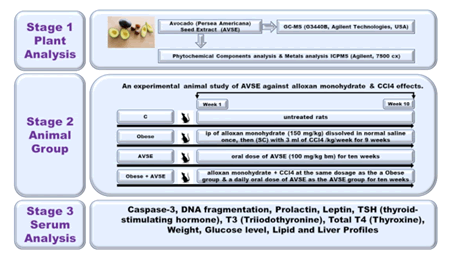
Figure 1: The experimental design.
Phytochemical components analysis: We trailed the technique of Bolajoko and Onyeaghala, 2020 for phytochemical contents of the avocado (Persea Americana) seed extract (AVSE) investigation for total phenolic, tannin, flavonoid, and alkaloids via a UV-Vis spectrophotometer 1000 series CECIL Instruments Limited, Milton Technical center Cambridge CB24 6AZ, England [4,16].
Metals analyses: We preceded our earlier method for inductively coupled plasma-mass spectrometry ICPMS (Agilent, 7500 cx) after digesting method to the avocado (Persea americana) seed oil with nitric acid via a microwave digestion technique (Milestone, Ethos 1) to investigate K, Na., Ca2+, Zn, iron, Pb, Cd, Al levels in AVSE [17].
Gas chromatography-mass spectrometry analysis: We tracked our preceding technique for GC–MS examination to identify the chemical contents of the avocado (Persea americana) AVSE extract via a gas chromatography system (G3440B, Agilent Technologies, USA) [13]. We then investigated the WILEY and NIST (National Institute of Standards and Technology) mass spectral libraries to recognize the chemical compositions of the AVSE extract [13].
The rat study
Animals: We had 60 adult female Sprague-Dawley rats weighing 120 ± 2 g in this study. The rats were tested for their health status at 26°C and given a standard diet and water daily for two weeks before the experiment began. After adaptation, the rats were separated into four groups of 15 female rats each. All animal experiments were accepted by the Experimental Animal Care department committee and followed the Three Rs (Replacement, Reduction, Refinement) [3]. We complied with all institutional and national guidelines for the care and handling of laboratory rats [3]. The four groups of animals alienated of the following: a control group of untreated rats; the obese group of rats injected with an intraperitoneal dose of 150 mg/kg alloxan monohydrate were acquired from Sigma-Aldrich (USA), once [4], then we injected rat subcutaneous, (SC) with 3 ml of CCl4/kg/week for 9 weeks [12]. An AVSE group of rats was treated with a daily oral dose of AVSE at 100 mg/ kg bm for ten weeks [18]. An obese +AVSE group of rats was inserted with alloxan monohydrate and CCl4 at the same dosage as the obese group then a daily oral dose of AVSE as the AVSE group for ten weeks [12,18]. After the experiment period, we obtained the serum separately for the biochemical assay.
Biochemical assays: We followed our previous method for the glucose level assay according to the method designated by Sarfraz et al, 2017 [4,19].
We analyzed caspase-3 using the standard protocol for kit BioSource International, Inc, and we measured the absorbance of the yellow color at 405 nanometers (nm) against a blank conduct a microplate reader (Bio-Tek Instruments, Germany). The elevation in caspase-3 activity was detected by direct comparison to the level of the control as optical density according to our previous work [20]. We analyzed DNA Fragmentation according to our previous study using a DNA purification kit [20]. Then, DNA was practical by electrophoresis on 1% Agarose gel including ethidium bromide, and visualized under UV light (Turnhout, Belgium) [20].
We analyzed total cholesterol, low density lipoproteins (LDL cholesterol [LDL-C]), high density lipoprotein (HDL cholesterol [HDL-C]), triglycerides, and the aspartate transaminase (AST) and alanine transaminase (ALT) level according to our previous study [3].
We followed our previous work and analyzed serum prolactin, TSH, T3, and T4 levels using the standard protocol for available kits by Roche/Hitachi Cobas e 601 analyzers (Roche Diagnostics, Mannheim, Germany) by electrochemiluminescence Immunoassay [21].
We analyzed Serum levels of leptin, rat ELISA kits (8400 Baltimore Avenue, MD, USA) according to the manufacture instructions [22].
Statistical analyses
The outcomes data were studied according to our preceding publication using IBM SPSS software version 20.0 (IBM Corp, Armonk, NY). The significance level of the tests detected was set at 5% [3].
Results
Table 1 represents the measured phytochemicals, and metal insides of AVSE The avocado (Persea americana) extracts.
Table 1: Analysis of phytochemical components and metals of AVSE.
| Components | Concentrations |
|---|---|
| Phytochemical | |
| Tannins (g/100g TAE) | 1.41 |
| Polyphenols (g/100g GAE) | 0.65 |
| Flavonoids (mg/100g CE) | 0.23 |
| Alkaloid (mg/g AE) | Not detected |
| Metals | |
| Na(mg/kg) | 1.21 |
| Ca2+(mg/kg) | 0.75 |
| Fe(mg/kg) | 0.2 |
| Zn(mg/kg) | 0.15 |
| K(mg/kg) | 2.89 |
| Cd (mg/kg) | Not detected |
| Pb (mg/kg) | Not detected |
| Al(mg/kg) | Not detected |
Table 2 reports the chemical composition of AVSE, the avocado (Persea americana) extracts identified by GC-MS [13].
Table 2: Gas chromatography-mass spectrometry analysis of the avocado (Persea americana) seed oil extract, AVSE.
| No. | Name | Base Peak | RT | Chromatogram |
|---|---|---|---|---|
| 1 | Cyclodecacyclododecene, 1,2,3,4,5,6,7,8,9,10,11,12,13,14,15,16,17,18-octadecahydro- | 94.1 | 12.3 | 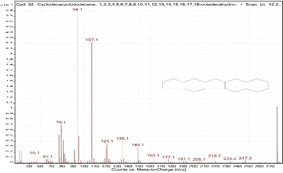 |
| 2 | 9-Octadecenamide, (Z)- | 59 | 14.02 | 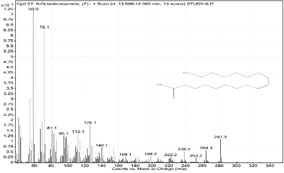 |
| 3 | 2H-Pyran, 2-(7-heptadecynyloxy)tetrahydro- | 81.1 | 12.89 | 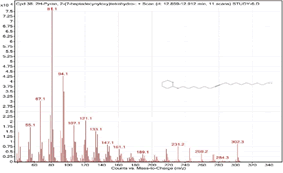 |
| 4 | E,Z-3,13-Octadecadien-1-ol acetate | 81.1 | 10.37 | 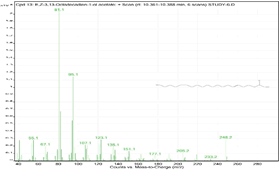 |
| 5 | 1-Hexadecyn-3-ol, 3,7,11,15-tetramethyl- | 69 | 13.11 | 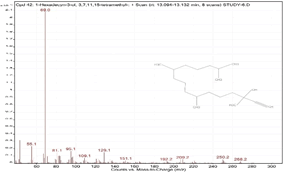 |
| 6 | Androstan-17-one, 3-ethyl-3-hydroxy-, (5.alpha.)- | 94.1 | 13.35 | 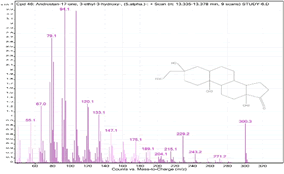 |
| 7 | Chrysene, octadecahydro- | 94.1 | 10.92 | 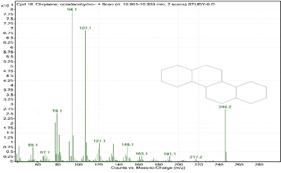 |
| 8 | 9-Octadecenamide, (Z)- | 59 | 14.08 | 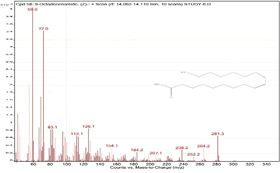 |
| 9 | cis-11-Eicosenamide | 59 | 15.14 | 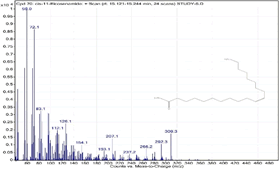 |
| 10 | Bicyclo[10.8.0]eicosane, (E)- | 81 | 11.79 | 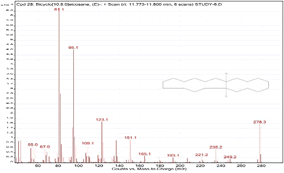 |
| 11 | Hexadecanamide | 69 | 12.95 | 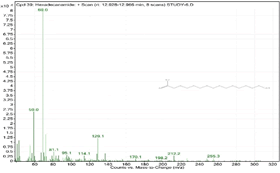 |
| 12 | dl-.alpha.-Tocopherol | 430.4 | 20.03 | 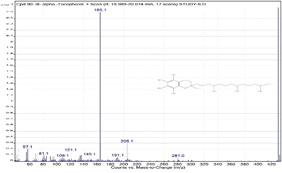 |
| 13 | Formic acid, 3,7,11-trimethyl-1,6,10-dodecatrien-3-yl ester | 121 | 13.78 | 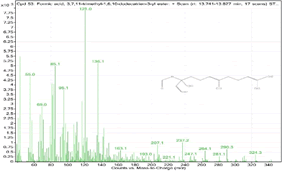 |
| 14 | cis-10-Nonadecenoic acid | 85.1 | 14.7 | 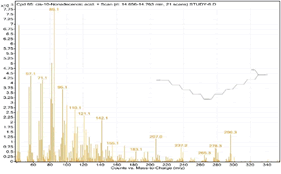 |
| 15 | Farnesol isomer a | 69 | 13.3 | 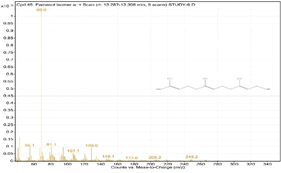 |
| 16 | 3-Chloropropionic acid, heptadecyl ester | 55 | 9.58 | 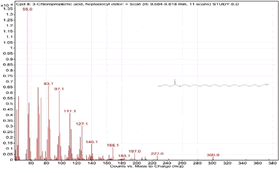 |
| 17 | Z,Z-4,6-Nonadecadien-1-ol acetate | 95.1 | 13.97 | 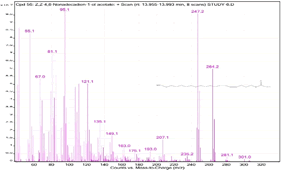 |
| 18 | 2H-Pyran, 2-(7-heptadecynyloxy)tetrahydro- | 85.1 | 15.72 | 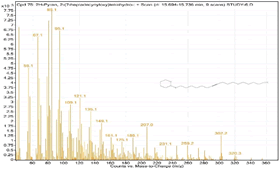 |
| 19 | 1-Heptatriacotanol | 95.1 | 16.15 | 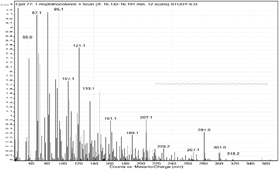 |
| 20 | Oleic Acid | 55 | 11.54 | 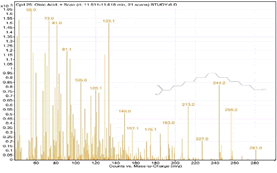 |
| 21 | Stigmastan-3,5-diene | 396.4 | 19.83 | 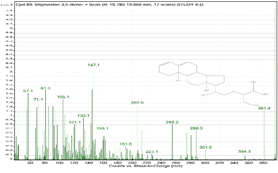 |
| 22 | Phenol, 2-undecyl- | 94.1 | 10.96 | 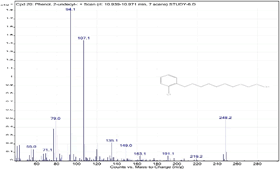 |
| 23 | .gamma.-Tocopherol | 151.1 | 19.05 | 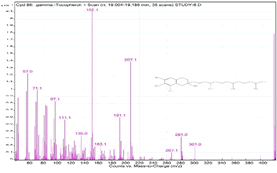 |
| 24 | p-Menth-8-en-3-ol, acetate | 121 | 12.52 | 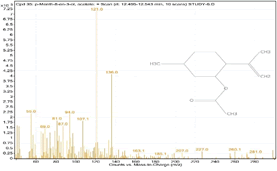 |
| 25 | Caryophyllene oxide | 95 | 13.17 | 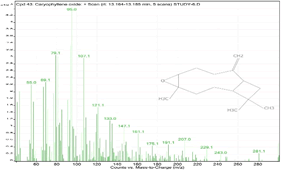 |
| 26 | Heptacosane | 57 | 17.48 |  |
| 27 | Propanoic acid, 3-mercapto-, dodecyl ester | 57.1 | 11.9 | 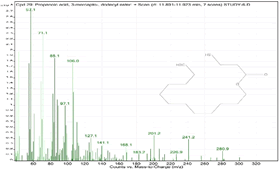 |
| 28 | 2-methyltetracosane | 43 | 11.04 | 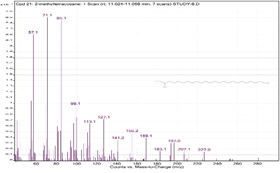 |
| 29 | 1,2-15,16-Diepoxyhexadecane | 69 | 13.21 | 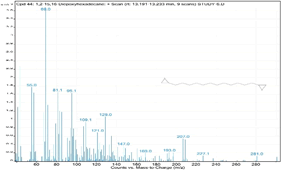 |
| 30 | 2-Bromotetradecane | 71.1 | 9.874 | 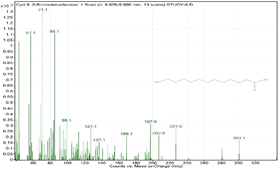 |
| *Notes: RT: Retention times (minutes); PA: peak area (%). GC–MS investigation was done for the Hexane: ethanoic (3:1) extracts and applied at Agilent Technologies (G3440B, USA). The composition of AVSE seed extract was standard by computer simulations in commercial libraries of Wiley and NIST (National Institute of Standards and Technology). | ||||
*Notes for Tables 2: GC–MS investigation was done for the Hexane: ethanoic (3:1) extracts and applied at Agilent Technologies (G3440B, USA). The composition of AVSE seed extract was standard by computer simulations in commercial libraries of Wiley and NIST (National Institute of Standards and Technology).
Figure 2 shows that alloxan monohydrate and CCl4 induced apoptosis which was indicated by a significant (p ≤ 0.05) elevation in the level of caspase-3(316.7%) and DNA fragmentation compared to the control group. Otherwise, the treatment of AVSE after alloxan monohydrate and CCl4 administration (obese +AVSE group) significantly (p ≤ 0.05) reduced the level of caspase-3 (42%) compared to handling with alloxan monohydrate and CCl4. On the other hand, the Agarose gel electrophoresis presented low DNA laddering in the serum of the control group. The DNA whole band seemed to contract near the application point with no DNA smearing, signifying no DNA fragmentation. Otherwise, alloxan monohydrate and CCl4 administration resulted in huge DNA fragmentation compared to Control (Figure 2B). While treatment with AVSE alone exhibited no DNA fragmentation. Treatment with AVSE during and post-monohydrate and CCl4 injection reduced DNA fragmentation compared to treatment with monohydrate and CCl4 alone (Figure 2B).
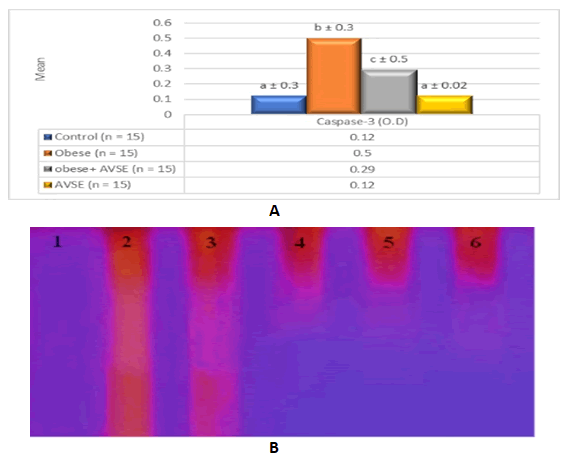
Figure 2: Apoptosis comparison of the different groups of the female rat’s study. (A) Caspase-3 activity (B) DNA fragmentation levels in four rat groups. Control=untreated rats; the obese group=rats injected with an intraperitoneal dose of 150 mg/kg alloxan monohydrate, once, then we injected rat subcutaneous, (SC) with 3 ml of CCl4 /kg/week for 9 weeks; the AVSE group=rats treated with a daily oral dose of AVSE at 100 mg/kg bm for ten weeks; the obese +AVSE group=rats inserted with alloxan monohydrate and CCl4 at the same dosage as the obese group then a daily oral dose of AVSE as the AVSE group for ten weeks. Data are given as the mean ± SD for 15 rats. Statistical significance was set at p ≤ 0.05; means signed by the same letters are not significantly different (a, b, c, a). DNA fragmentation in serum. DNA fragmentation separating in 1% agarose gel electrophoresis and pictured under UV. DNA in serum (lane 1, 6-control, lanes 2, 3-obese, lanes 4-obese-AVSE, lane 5-AVSE). The DNA complete band seems to shrink close to the application well with no DNA smearing, signifying no DNA fragmentation.
Figure 3 shows the results for the different parameters studied, given as mean ± SD for 15 rats. Figure 3 shows that alloxan monohydrate and CCl4 initiated hormonal disturbance, obesity, hyperlipidemia, and hyperglycemia in animals, which was indicated by a significant (p ≤ 0.05) elevation in the levels of prolactin (↑ 103.1%), leptin (↑ 136.8%), TSH (↑83.3%), and decrease in T3 (↓ 32.3%), total T4(↓99.5%) compared to the control group. This was linked to a significant (p ≤ 0.05) increase in total cholesterol (49.7%), triglycerides (94.8%), LDL-C (24.3%), AST (126.2%), ALT (120%), and glucose (531.5%) related to the control group, while the obese group presented a significant 27.6% decline in HDL-C round to the control group.
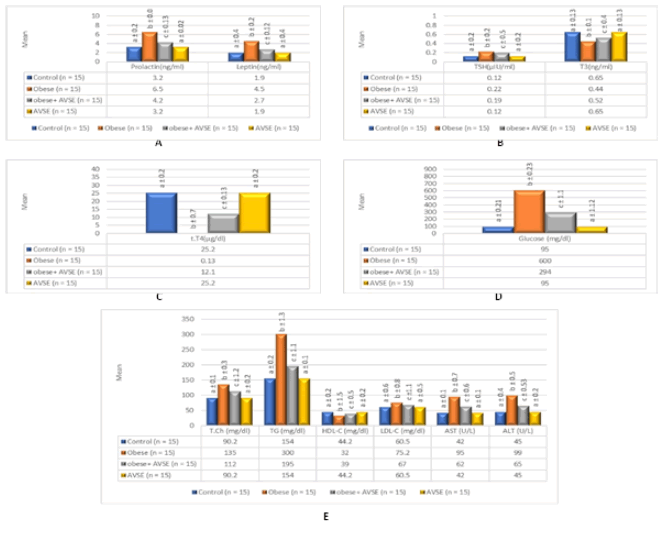
Figure 3: Biochemical comparison of serum of the different groups in the female rat study. (A) Prolactin and Leptin; (B)TSH (thyroid-stimulating hormone), and T3(Triiodothyronine); (C) total T4 (Thyroxine); (D) glucose; (E) Total cholesterol, triglycerides (TG), ), high-density lipoprotein (HDL), low-density lipoprotein (LDL), aspartate transaminase (AST) and alanine transaminase (ALT) levels in four rat groups; Control=untreated rats; the obese group=rats injected with an intraperitoneal dose of 150 mg/kg alloxan monohydrate, once, then we injected rat subcutaneous, (SC) with 3 ml of CCl4 /kg/week for 9 weeks; the AVSE group=rats treated with a daily oral dose of AVSE at 100 mg/kg bm for ten weeks; the obese +AVSE group=rats inserted with alloxan monohydrate and CCl4 at the same dosage as the obese group then a daily oral dose of AVSE as the AVSE group for ten weeks. Data are given as the mean ± SD for 15 rats. Statistical significance was set at p ≤ 0.05; means signed by the same letters are not significantly different (a, b, c, a).
The treatment of AVSE after alloxan monohydrate and CCl4 administration (obese +AVSE group) significantly (p ≤ 0.05) regulated the considered parameters prolactin, leptin, TSH, T3, and total T4 levels by ↓35.4%, ↓40%, ↓13.6%, ↑ 18.2%, and ↑9207%, respectively, compared to handling with alloxan monohydrate and CCl4 (Figure 3). This was accompanied by a significant (p ≤ 0.05) reduction in total cholesterol, triglycerides, LDL-C, AST, ALT, and glucose by 17%, 35%, 10.9%, 34.7%, 34.3%, and 51% respectively, compared to the concentrations in the obese group (Figures 3B and 3C). Otherwise, the obese +AVSE group obtainable a significant 21% rise in the HDL-C serum concentration compared to that of the obese group, p ≤ 0.05; (Figures 3D and 3E). While the rats treated only avocado seed oil extract for ten weeks (the AVSE group) presented no variation in the levels of all studied parameters (Figures 2 and 3).
On the other hand, Figure 4 shows the results for the female rat weight, given as mean ± SD for 15 rats and the gradual increase of the weight in four studied groups. Figure 4 shows that alloxan monohydrate and CCl4 induced weight increase and obesity as compared to control. Otherwise, the treatment of AVSE after alloxan monohydrate and CCl4 administration showed a significant reduction in weight as compared to the obese group. Furthermore, there is a significant reduction in the weight in AVSE alone as compared to control without any change in the remaining studied parameters as compared to the control (Figures 2-4).
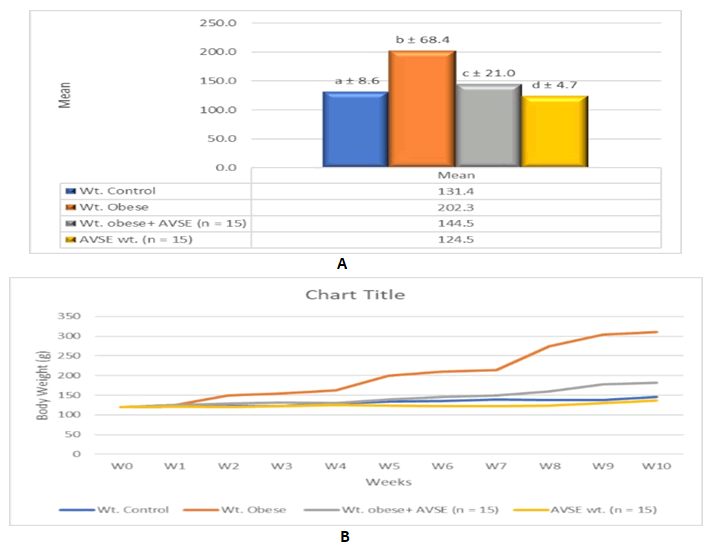
Figure 4: Body Weight comparison of the different groups in the female rat study. (A) Mean of final weight gain >over 10 weeks in all studied groups (B) the gradual change in body weight over 10 weeks in all studied groups. Control=untreated rats; the obese group=rats injected with an intraperitoneal dose of 150 mg/kg alloxan monohydrate, once, then we injected rat subcutaneous, (SC) with 3 ml of CCl4/kg/week for 9 weeks; the AVSE group=rats treated with a daily oral dose of AVSE at 100 mg/kg bm for ten weeks; the obese +AVSE group=rats inserted with alloxan monohydrate and CCl4 at the same dosage as the obese group then a daily oral dose of AVSE as the AVSE group for ten weeks. Data are given as the mean ± SD for 15 rats. Means signed by the same letters are not significantly different (a, b, c, d).
Discussion
Obesity is associated with inflammatory diseases, hyperglycemia, infection aggravation, cell death, and increased death rates in the world [23,24].
The obesity obstacle is marked by increased disorder in hormone balances, lipid, and glucose metabolism. Also, obesity associated with an accumulation of pro-oxidant, hyperlipidemia, and inflammatory mediators is an inducer of apoptosis and cell death; the result in this study for the group with alloxan monohydrate and CClL4-induced obesity, hyperlipidemia, hyperglycemia, and apoptosis, compared to the control group, agrees with this [12,23].
This alarm may lead to the diseases such as blood sepsis initiation cell death, and multiple disorder which may increase pathological disorders such as immune, cardio, and hepatic disturbances, especially in individuals with raised genetic susceptibility [25,23].
Our results are shown in Figures 2 and 3 agree with previous reports that obesity and diabetes activate hormonal disturbance and apoptosis responses. We found higher levels of caspase-3, DNA fragmentation, prolactin, leptin, TSH (thyroid-stimulating hormone), T3(Triiodothyronine), and total T4 (Thyroxine) and weight, glucose, lipid, and liver profiles caused by alloxan monohydrate and CCl4 in rats, compared to the control group (Figure 3).
A previous investigation reported that obesity and hyperlipidemia increased infertility in female rats and disturbance of estradiol, progesterone, luteinizing hormone (LH), and upregulation prolactin levels agree with the current investigation [26].
Our results are in agreement with our previous work that reported elevation in lipid and liver profiles and disturbance in the hormones with thyroid hormones including TSH, T3, and total T4 after administration of CCl4 [12]. To initiate obesity and diabetes that can trigger pro-oxidants, hormonal change, inflammatory reactions, and pro-apoptosis, we injected the female rats in this investigation with alloxan monohydrate and CCl4. According to our previous work alloxan monohydrate induced diabetes in rats and elevated, lipid and glucose levels [4]. Furthermore, CCl4 and its metabolite, trichloromethyl free radicals, reacted with protein and lipid within the cell; this reaction enhanced with oxygen and produced free radicals, which attack lipids on the membrane and led to cell death [27-29]. As well as, CCl4 initiation fatty liver and lipidemia in many of the previous investigations, which agree with the current study. Moreover, CCl4 induced the inflammatory protein, lipid peroxidation, liver injuries, and hyperlipidemia in the systemic oxidative stress necroinflammation in turn affecting the thyroid and other rat body organs, which agree with the current study [30,12].
The present work stated the elevation of caspase-3, DNA fragmentation, prolactin, leptin, TSH (thyroid-stimulating hormone), T3 (Triiodothyronine), and total T4 (Thyroxine) levels results in hyperglycemia, hyperlipidemia, obesity, weight, and diabetes complications. A current investigation represented an elevation in all studied parameters in the obese groups more than in the control group in the rat study.
Dealing with obesity and diabetes includes medication, insulin medicine, a healthy diet, and an energetic lifestyle. Herbal medicine and functional food including fruits and vegetables are measured as the most current choice recently [10,31].
The avocado (Persea Americana) is a constituent of the Lauraceae family. Our recent investigation reported that avocado seeds contain components such as palmitic acid and volatile compounds, androstane-17-one, 11-eicosenoic acid, monounsaturated omega-9 fatty, alpha-tocopherol, and gamma-tocopherol [13], which agree with the current study (Table 1). Moreover, previous reports indicate that avocado seed oil contains unsaturated fatty acids, tocopherols, tocotrienols, phytosterols, carotenoids, polyphenols, vitamins, and healthy minerals which agree with the current study (Tables 1 and 2).
The present study identifies beneficial phytochemicals, sterols, healthy fatty acids, carotenes, and flavonoids that have numerous medicinal. The present study reported that AVSE included polyphenols, flavonoids, and Tannins (Tables 1 and 2). Our present investigation also stated that AVSE contains essential nutrients such as K, Na., Ca2+, Zn, and iron with the absence of heavy toxic metals Pb, Cd, and Al (Table 1) which reflect the avocado (Persea americana) seed extract a healthy natural herbal medication. These results agree with the previous investigation that reported that the avocado (Persea americana) seed extract is used as an anti-obesity, anti-inflammatory, anti-apoptotic, and antioxidant treatment [31-33].
Our prior publication stated that avocado seed oil extract has a synergetic repressive as an anti-inflammatory, antistress, and anti-oxidant and concluded docking trial binding free energy with exact receptor as an advantageous antioxidant [13]. As we reported before and in this current investigation that avocado seed oil contains octadecenamide, eicosenamide, healthy sterol, hexadecanamide, oleic acid, phytochemistry, tocopherol, pyran, and their byproducts; these have antistress, antidepressant, sedation mood effect, antioxidant, anticancer, antibacterial, and antilipidemic effects [3,13,20,34,35] These polyphenols have a significant role as, antidiuretic, and antilipidemic antioxidants to capture free radicals [4].
Bottom line, the current study agrees with the previous investigation, where we reported an improvement in the measured biological parameters after treatment with avocado seed oil extract in female rats against the administration with alloxan monohydrate and CCl4 obese group compared to the control. As well as after oral administration of AJSO to rats following obese initiation, there is a regulation in the level of caspase-3, DNA fragmentation, prolactin, leptin, TSH (thyroid-stimulating hormone), T3 (Triiodothyronine), and total T4 (Thyroxine) and weight, glucose, lipid, and liver profiles in the obese +AVSE group than in the obese group. Furthermore, there are advancements in the weight in AVSE alone without any change in the remaining considered analysis as compared to control. This may be due to the combination of avocado seed phytochemical synergistic advantageous outcome through the reduction of apoptosis, hyperlipidemia, hyperglycemia, and hormonal regulation that led to enhancement in biological profiles.
Conclusion
We reported the management of CCl4 and alloxan monohydrate induced hormonal disturbance, obesity, diabetes, and apoptosis by AVSE extract. Where, there was a decline in caspase-3, DNA fragmentation, prolactin, leptin, TSH (thyroid-stimulating hormone), T3 (Triiodothyronine), total T4 (Thyroxine), weight, glucose, lipid, and liver profiles in the obese +AVSE group compared to the rats treated with CCl4 and alloxan monohydrate. The percent of change obese +AVSE group to the obese group; caspase-3, prolactin, leptin, TSH, T3, and total T4 levels showed adjustment of ↓ 42%, ↓ 35.4%, ↓ 40%, ↓ 13.6%, ↑ 18.2%, and ↑ 9207% respectively. Furthermore, the percent of the diminishing change between the obese +AVSE group to the obese group; showed in total cholesterol, triglycerides, LDL-C, AST, ALT, and glucose by 17%, 35%, 10.9%, 34.7%, 34.3%, and 51% respectively. We confirm AVSE extract is the opening point herbal treatment for the prevention/control of hormonal disturbances, obesity, diabetes, and apoptosis.
Acknowledgments
The authors are grateful to the universities and institutions that helped in this research.
Author Contributions
Asmaa Fathi Hamouda and Shifa Felemban have equally contributed to designing and accomplishing the experiments, analyzing and interpreting the results as well as writing and revising the manuscript.
Competing Interests Disclaimer
No competing financial interests exist.
References
- A.F. Hamouda, I.A. Khardali, I.M. Attafi, M.E. Oraiby, M.A. Attafi, et al. Study the relation between acetylcholinesterase and obesity in University students, Int J Nutr Food Sci, 8(2019), 46-51.
- L. Eder, F. Abji, C.F. Rosen, V. Chandran, D.D. Gladman, The association between obesity and clinical features of psoriatic arthritis: A case-control study, J. Rheumatol, 44(2017), 437-443.
[Crossref] [Google Scholar] [PubMed] [Research Gate]
- A.F. Hamouda, A pilot study of antistress effects of vitamin b complex and agarwood extract in an animal model with parallel observations on depression in human subjects, J Drug Alcohol Res, 10(2021), 1-13.
[Google Scholar] [PubMed]
- S. Felemban, A.F. Hamouda, A pilot study of the effects of ajwa date seed extract in a diabetic animal with parallel observations on human subjects, J Pharm Res Int, 34(2022), 23-33.
- P.M. Pêgo-Fernandes, B.J. Bibas, M. Deboni, Obesity: the greatest epidemic of the 21st century?, Sao Paulo Med J, 129(2011), 283-284.
[Crossref] [Google Scholar] [PubMed] [Research Gate]
- C. G. Edwards, Effects of 12-week avocado consumption on cognitive function among adults with overweight and obesity, Int J Psychophysiol, 148(2020), 13-24.
[Crossref] [Google Scholar] [PubMed] [Research Gate]
- I. Imaz, C. Martínez-Cervell, E.E. García-Álvarez, J.M. Sendra-Gutiérrez, J. González-Enríquez, Safety and effectiveness of the intragastric balloon for obesity: A meta-analysis, Obes Surg, 18(2008), 841-846.
[Crossref] [Google Scholar] [PubMed] [Research Gate]
- L.A. Barness, J.M. Opitz, E. Gilbert-Barness, Obesity: Genetic, molecular, and environmental aspects, Am J Med Genet. 143A(2008), 3016–3034.
[Crossref] [Google Scholar] [PubMed] [Research Gate]
- M. Weintraub. Long-term weight control study. I (weeks 0 to 34). The enhancement of behavior modification, caloric restriction, and exercise by fenfluramine plus phentermine versus placebo, Clin Pharmacol Ther, 51(1992), 586-594.
[Crossref] [Google Scholar] [PubMed] [Research Gate]
- A.F. Hamouda, S.E.D.A.A.E Noeman, Effects of 6-Month Weight Loss New Program on Anthropometric Measurements and Biological Profile, J Pharm Pharmacol, 4(2016), 23–38.
- T. Belete Bahru, Z. Hailu Tadele, E. Gebrie Ajebe, F. Marquez-Linares, A review on avocado seed: functionality, composition, antioxidant and antimicrobial properties, Chem Sci Int J, 27(2019), 1-10.
- A.F. Hamouda, M. Y. Sameeh, R.M. Shrourou, Effect of avocado (Persea americana), Cabbage (Brassica oleracea) and Ginger (Zingiber officinale) on rat liver and thyroid injuries induced by CCl4 (Carbon Tetrachloride), J Pharm Pharmacol, 4(2016), 108-118.
- A. F. Hamouda, T.M. Farawilla, I.M. Attafi, I.A. Khardali, M.A. Attafi, Screening pilot study of fruit seed compositions by GC-MS and their potential scenario anti ACE2 and 2rh1 receptors as a recycling possibility in the coronavirus pandemic, J Clin Med Res, 2 (2021), 1-65.
- S.V. Thompson, Avocado consumption alter gastrointestinal bacteria abundance and microbial metabolite concentrations among adults with overweight or obesity: A randomized controlled trial, J Nutr, 151(2021), 753-762.
[Crossref] [Google Scholar] [PubMed] [Research Gate]
- P. Monika, A. Geetha, Effect of hydroalcoholic fruit extract of Persea americana mill on high fat diet induced obesity: A dose response study in rats, Indian J Exp Biol, 54(2016), 370-378.
- E. Bolajoko, A.A. Onyeaghala, O. Akinosun, A. Attah, J.O. Moody, et al. Comparative proximate, phytochemical and mineral contents of freeze-dried and aqueous extracts of Vernonia amygdalina Del leaves and garcinia kola heckel seeds, Int J Herbs Pharmacol Res, 9(2020), 2-13, 2020.
- A.F. Hamouda, A.A.M. Hassan, I.A. Khardali, A Screening pilot study on the relation between body mass index, and heavy metal and mineral levels in college students, Artic Electron J Biol, 15 (2019), 79-89.
- R.I. Ozolua, O.N. Anaka, S.O. Okpo, S.E. Idogun, Acute and sub-acute toxicological assessment of the aqueous seed extract of Persea americana mill (Lauraceae) in rats, African J Tradit Complement Altern Med. 6 (2009), 573-578.
[Crossref] [Google Scholar] [PubMed] [Research Gate]
- M. Sarfraz, T. Khaliq, J.A. Khan, B. Aslam, Effect of aqueous extract of black pepper and ajwa seed on liver enzymes in alloxan-induced diabetic Wister albino rats, Saudi Pharm J SPJ Off Publ Saudi Pharm Soc, 25(2017), 449-452.
[Crossref] [Google Scholar] [PubMed] [Research Gate]
- A.F. Hamouda, A biochemical study of agarwood on methanol injection in rat, J Drug Alcohol Res, 8(2019).
- A.F. Hamouda, A biochemical study of chronic stress and chronic inflammation fibromyalgia, Pharm Pharmacol Int J, 6(2018), 234-243.
- H.H. Atteia, Evening primrose oil ameliorates hyperleptinemia and reproductive hormone disturbances in obese female rats: Impact on estrus cyclicity, Front Endocrinol (Lausanne), 10(2019), 942–942.
[Crossref] [Google Scholar] [PubMed] [Research Gate]
- N. El-Fetoh, Relationship between obesity and immune system a review article, Int J Approx Reason, 4(2016), 23-29.
- D.L. de Frel, The impact of obesity and lifestyle on the immune system and susceptibility to infections such as COVID-19, Front Nutr, 7 (2020), 279.
[Crossref] [Google Scholar] [PubMed] [Research Gate]
- A.S. Kolyva, The role of obesity in the immune response during sepsis, Nutr Diabetes. 49(2014), 1-7.
[Crossref] [Google Scholar] [PubMed] [Research Gate]
- S.C. Sagae, Early onset of obesity induces reproductive deficits in female rats, Physiol Behav, 105 (2012), 1104–1111.
[Crossref] [Google Scholar] [PubMed] [Research Gate]
- R.O. Recknagel, E.A. Glende, J.A. Dolak, R.L. Waller, Mechanisms of carbon tetrachloride toxicity, Pharmacol Ther, 43(1989), 139–154.
[Crossref] [Google Scholar] [PubMed] [Research Gate]
- N.M. Abdel-Hamid, Diphenyl dimethyl bicarboxylate as an effective treatment for chemical-induced fatty liver in rats, African J Biomed Res, 9(2006), 77-81.
- A.F. Hamouda, N. Z. Shaban, Effects of some pyrimidine derivatives and pomegranate juice on male rat kidney injuries induced by diethylnitrosamine and carbon tetrachloride, Int Sci J J Med Biol Sci, (2015).
- M.M. Abu-Serie, A.F. Hamouda, N.H. Habashy, Acacia senegal gum attenuates systemic toxicity in CCl 4-intoxicated rats via regulation of the ROS/NF-κB signaling pathway, Sci Rep, 11(2021), 20316.
[Crossref] [Google Scholar] [PubMed] [Research Gate]
- M. Flores, C. Saravia, C.E. Vergara, F. Avila, H. Valdés, et al. Avocado oil: characteristics, properties, and applications, Molecules, 24(2019), 2172.
[Crossref] [Google Scholar] [PubMed] [Research Gate]
- L. Retief, J.M. McKenzie, K. R. Koch, A novel approach to the rapid assignment of 13C NMR spectra of major components of vegetable oils such as avocado, mango kernel and macadamia nut oils, Magn Reson Chem, 47(2009), 771-781.
[Crossref] [Google Scholar] [PubMed] [Research Gate]
- O. Ortiz-Avila, Protective effects of dietary avocado oil on impaired electron transport chain function and exacerbated oxidative stress in liver mitochondria from diabetic rats, J Bioenerg Biomembr, 47(2015), 337-353.
[Crossref] [Google Scholar] [PubMed] [Research Gate]
- H. Ding, Y.W. Chin, A.D. Kinghorn, S.M. D’Ambrosio, Chemopreventive characteristics of avocado fruit, Semin Cancer Biol, 17(2007), 386-394.
[Crossref] [Google Scholar] [PubMed] [Research Gate]
Copyright: © 2022 Asmaa Fathi Hamouda, et al. This is an open access article distributed under the terms of the Creative Commons Attribution License, which permits unrestricted use, distribution, and reproduction in any medium, provided the original work is properly cited.

